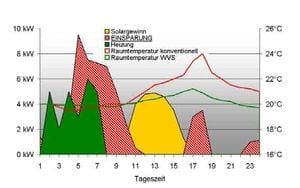Energy Cost Saving by Weather Forecast
The morning weather forecast says it all – cold snap! Though you don’t feel the cold yet, you prepare for it. Set a foot outside the door at lunchtime and you know it was a good idea to wrap yourself up in a winter coat. When you come home in the late afternoon you notice that your flat is slightly chilly, “Let’s turn up the heating” is the first thought that goes through your head. In the evening, however, it’s like sitting in an oven. Does it have to be so? Can’t the building heating, in principle, react in the same way as I did when I put my coat on early enough?
The Aachen company MeteoViva® GmbH has developed a Europe-wide patented process and transformed it into a high performance product. The hardware basis for this is the Gipsy Boxes from Gesytec GmbH. The motivation to install the product is naturally not only the thought of extra comfort, but above all the derived energy savings. A saving of up to 35% of energy costs is made through a foresighted control of the lethargic system of a building and its heating and the well timed shutting down of aggregates, such as pumps.
This solution is possible due to the quality of today’s weather forecasts. They do not only give acceptably accurate information for a number of days, but they are – and this is important for the specific property – also available in a small effective regional radius. What use is the weather forecast for a federal state when significant temperature differences are noticeable over a distance of 20 km?
Apart from the weather forecast, individual building data is incorporated in the optimization procedures from MeteoViva. An exact simulation model furthermore takes into account the systems technology and naturally also the pattern of use.
How does this patented solution actually work? The calculation of the control data takes place in a “data processing center” which has available the current weather forecast as well as the model of the buildings being served. Where this data processing center is and who is responsible for it is irrelevant to the technical procedures. The results of the calculations are optimal control parameters for the next 2 to 3 days which are then transferred to the property.
During the communication with and the local control of the property the Gipsy comes into play. As a MeteoViva-Box the Gipsy is the linking appliance between the data processing center and technical installations of the the building. It receives the control information via analog or ISDN-Modem, GSM or over Ethernet and connects it via OPC or LonWorks to the technical installations. Furthermore it can administer additional switching operations. In addition performance data and metered values from the building and the installations are recorded and regularly reported. This helps with error detection and the enhancement of the simulation model. Naturally any malfunction messages are also captured and processed in this way. As an embedded PC with Windows CE the Gipsy can, in addition to the basic functions, also adopt further application specific functions, like monitoring other parts of the building automation.
The transfer of the control function to a data processing center does not mean relinquishing individual configuration. The functions for the required level of air-conditioning and amending user profiles can be adapted without expert knowledge over an Internet portal at any time giving comfortable and sound optimized energy utilization.

